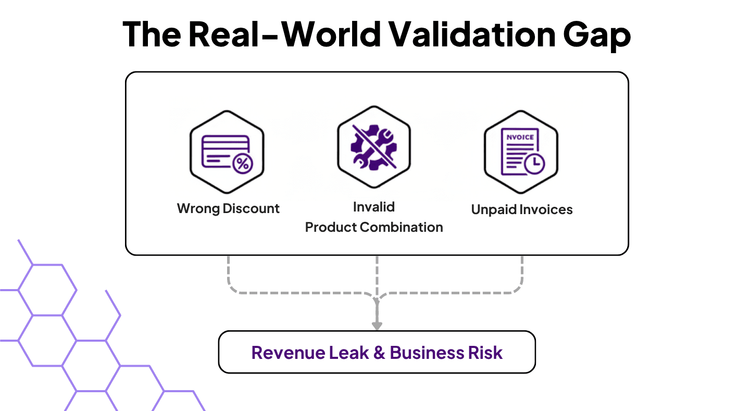Your ERP is the backbone of your company, the single source of truth for your most critical data. But when it's obligated to enforce the messy, nuanced, "how-we-actually-do-business" rules, that backbone chokes. It simply wasn't designed for the agility your specific operations demand. The result is a cascade of predictable problems: bad data, frustrated users, and broken workflows that quietly bleed revenue.
The Real-World Validation Gap
This challenge goes far beyond simple data entry checks. It's about enforcing the complex, conditional rules your business actually runs on. For example, the ERP's gatekeeper is supposed to prevent a sales rep from applying a "First-Time Customer" discount to a ten-year loyal client. It's supposed to block an order for a "Premium Support Package" when the customer doesn't own the base product. Critically, it's supposed to alert your finance team that a customer is 90 days late on their last five invoices before they are approved for another line of credit. When these contextual validations fail, they create more than just bad data, they create revenue leaks and significant business risk.
To address these validation gaps, many ERPs offer built-in workflow modules. However, these tools often deepen the customization trap. They introduce another layer of proprietary, rigid logic that requires specialized consultants to implement and maintain, further locking you into the vendor's ecosystem and complicating future upgrades.
Worse, these tools often fail users at the most critical moment. When a validation rule fails, the user isn't given helpful guidance, they are simply blocked by a cryptic error code like Error 74B-1: Invalid State. The process grinds to a halt, the user is frustrated, and the only "next step" is to file another ticket with IT. The workflow doesn't guide them; it simply puts up another wall.

Introducing the Solution (The BRE)
The architectural best practice is not to force the ERP to be something it's not. The solution is to decouple your business logic. By externalizing the dynamic, frequently-changing validation rules to a dedicated Business Rule Engine (BRE), you allow each system to perform its optimal function. This approach empowers your business users - the domain experts - to see, manage, and control their own logic in a user-friendly environment, without needing to touch the core ERP code.
Intelligent Validation in Action
A decoupled BRE does more than just validate, it guides. Your ERP's idea of "validation" is a cryptic "Error 74B-1" that dead-ends the user and spawns another IT ticket. A BRE replaces that roadblock with a guardrail. Through a simple API call, the ERP sends the transaction context to the BRE. The BRE executes its rules and returns not just a "false" when a validation fails, but a structured response containing the reason and the remedy. Instead of seeing 'Invalid Product Combination,' your sales rep now sees a contextual, helpful message: 'Action Required: This part is incompatible with the customer's X-200 model. Select from the X-250 or X-300 series to proceed.' This transforms validation from a frustrating dead end into a self-correcting process that improves data quality and actually gets work done.
Shifting Ownership from IT to the Business
This architectural shift introduces a profound change in ownership. The responsibility for maintaining dynamic business logic moves from a perpetually backlogged IT department to the business users who are the actual domain experts: the analysts, product managers, and compliance officers. This isn't just about shuffling tasks, it's a strategic realignment. You free up your most expensive engineering talent to focus on core systems and innovation, while empowering your business experts to react to market changes in minutes, not months. The result is a dramatic increase in agility and a significant reduction in operational cost.
The Only Realistic Model for Enterprise Agility
This hybrid approach isn't a compromise; it's the only realistic model for enterprise-grade agility. You get business-managed rules for the 80% of your logic that needs to be fast and flexible, and architect-governed code for the 20% that demands raw power. The result is a decoupled architecture with zero functional gaps and zero governance blind spots.
Your ERP is a great core system but a not so great decision-maker. It's time to let it do its job.

Jan Binko
Product Owner



